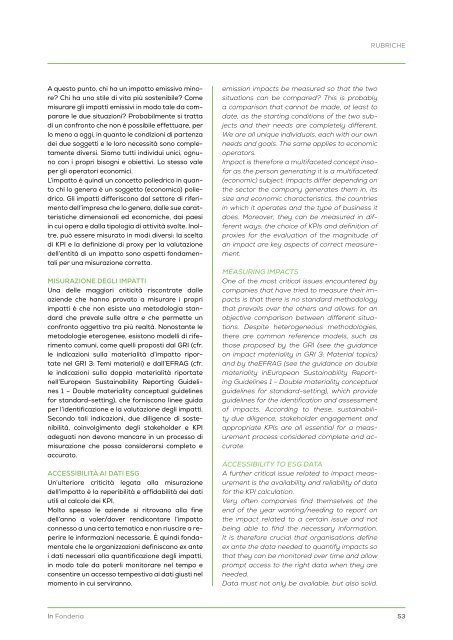In Fonderia 6 2023
Sesto numero del 2023 di In Fonderia
Sesto numero del 2023 di In Fonderia
You also want an ePaper? Increase the reach of your titles
YUMPU automatically turns print PDFs into web optimized ePapers that Google loves.
RUBRICHE<br />
A questo punto, chi ha un impatto emissivo minore?<br />
Chi ha uno stile di vita più sostenibile? Come<br />
misurare gli impatti emissivi in modo tale da comparare<br />
le due situazioni? Probabilmente si tratta<br />
di un confronto che non è possibile effettuare, per<br />
lo meno a oggi, in quanto le condizioni di partenza<br />
dei due soggetti e le loro necessità sono completamente<br />
diversi. Siamo tutti individui unici, ognuno<br />
con i propri bisogni e obiettivi. Lo stesso vale<br />
per gli operatori economici.<br />
L’impatto è quindi un concetto poliedrico in quanto<br />
chi lo genera è un soggetto (economico) poliedrico.<br />
Gli impatti differiscono dal settore di riferimento<br />
dell’impresa che lo genera, dalle sue caratteristiche<br />
dimensionali ed economiche, dai paesi<br />
in cui opera e dalla tipologia di attività svolte. <strong>In</strong>oltre,<br />
può essere misurato in modi diversi: la scelta<br />
di KPI e la definizione di proxy per la valutazione<br />
dell’entità di un impatto sono aspetti fondamentali<br />
per una misurazione corretta.<br />
MISURAZIONE DEGLI IMPATTI<br />
Una delle maggiori criticità riscontrate dalle<br />
aziende che hanno provato a misurare i propri<br />
impatti è che non esiste una metodologia standard<br />
che prevale sulle altre e che permette un<br />
confronto oggettivo tra più realtà. Nonostante le<br />
metodologie eterogenee, esistono modelli di riferimento<br />
comuni, come quelli proposti dal GRI (cfr.<br />
le indicazioni sulla materialità d’impatto riportate<br />
nel GRI 3: Temi materiali) e dall’EFRAG (cfr.<br />
le indicazioni sulla doppia materialità riportate<br />
nell’European Sustainability Reporting Guidelines<br />
1 – Double materiality conceptual guidelines<br />
for standard-setting), che forniscono linee guida<br />
per l’identificazione e la valutazione degli impatti.<br />
Secondo tali indicazioni, due diligence di sostenibilità,<br />
coinvolgimento degli stakeholder e KPI<br />
adeguati non devono mancare in un processo di<br />
misurazione che possa considerarsi completo e<br />
accurato.<br />
ACCESSIBILITÀ AI DATI ESG<br />
Un’ulteriore criticità legata alla misurazione<br />
dell’impatto è la reperibilità e affidabilità dei dati<br />
utili al calcolo dei KPI.<br />
Molto spesso le aziende si ritrovano alla fine<br />
dell’anno a voler/dover rendicontare l’impatto<br />
connesso a una certa tematica e non riuscire a reperire<br />
le informazioni necessarie. È quindi fondamentale<br />
che le organizzazioni definiscano ex ante<br />
i dati necessari alla quantificazione degli impatti,<br />
in modo tale da poterli monitorare nel tempo e<br />
consentire un accesso tempestivo ai dati giusti nel<br />
momento in cui serviranno.<br />
emission impacts be measured so that the two<br />
situations can be compared? This is probably<br />
a comparison that cannot be made, at least to<br />
date, as the starting conditions of the two subjects<br />
and their needs are completely different.<br />
We are all unique individuals, each with our own<br />
needs and goals. The same applies to economic<br />
operators.<br />
Impact is therefore a multifaceted concept insofar<br />
as the person generating it is a multifaceted<br />
(economic) subject. Impacts differ depending on<br />
the sector the company generates them in, its<br />
size and economic characteristics, the countries<br />
in which it operates and the type of business it<br />
does. Moreover, they can be measured in different<br />
ways: the choice of KPIs and definition of<br />
proxies for the evaluation of the magnitude of<br />
an impact are key aspects of correct measurement.<br />
MEASURING IMPACTS<br />
One of the most critical issues encountered by<br />
companies that have tried to measure their impacts<br />
is that there is no standard methodology<br />
that prevails over the others and allows for an<br />
objective comparison between different situations.<br />
Despite heterogeneous methodologies,<br />
there are common reference models, such as<br />
those proposed by the GRI (see the guidance<br />
on impact materiality in GRI 3: Material topics)<br />
and by theEFRAG (see the guidance on double<br />
materiality inEuropean Sustainability Reporting<br />
Guidelines 1 - Double materiality conceptual<br />
guidelines for standard-setting), which provide<br />
guidelines for the identification and assessment<br />
of impacts. According to these, sustainability<br />
due diligence, stakeholder engagement and<br />
appropriate KPIs are all essential for a measurement<br />
process considered complete and accurate.<br />
ACCESSIBILITY TO ESG DATA<br />
A further critical issue related to impact measurement<br />
is the availability and reliability of data<br />
for the KPI calculation.<br />
Very often companies find themselves at the<br />
end of the year wanting/needing to report on<br />
the impact related to a certain issue and not<br />
being able to find the necessary information.<br />
It is therefore crucial that organisations define<br />
ex ante the data needed to quantify impacts so<br />
that they can be monitored over time and allow<br />
prompt access to the right data when they are<br />
needed.<br />
Data must not only be available, but also solid.<br />
<strong>In</strong> <strong>Fonderia</strong><br />
53














